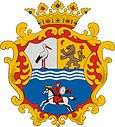Mezőtúr
| Mezőtúr | ||
|---|---|---|
|
Town hall | ||
| ||
 Mezőtúr | ||
| Coordinates: 47°00′N 20°38′E / 47.000°N 20.633°E | ||
| Country |
| |
| County | Jász-Nagykun-Szolnok | |
| District | Mezőtúr (seat) | |
| Area | ||
| • Total | 289.72 km2 (111.86 sq mi) | |
| Population (2001) | ||
| • Total | 19,483 | |
| • Density | 67/km2 (170/sq mi) | |
| Time zone | CET (UTC+1) | |
| • Summer (DST) | CEST (UTC+2) | |
| Postal code | 5400 | |
| Area code(s) | 56 | |
Mezőtúr (German: Thur) is a town of Hungary, in the county of Jász-Nagykun-Szolnok, 88 m. southeast of Budapest by rail. It possesses important potteries. Large herds of cattle are reared on the communal lands, which are productive also of wheat, rapeseed and maize. Several well-attended fairs are held here annually.
Location
Mezőtúr lies in the centre of the Great Hungarian Plain, on the banks of the Hortobágy-Berettyó, near the Budapest–Szolnok–Békéscsaba railway line.
History

The town was founded in the Middle Ages and it was called Túr after the river Berettyó, which was formerly named Túr. Later it was named Mezőtúr (mező means field, referring to the good soil of the Great Plain.) The town was first mentioned under King Andrew II (1205–1235) as villa Tur. The shortest road between Buda and Transylvania led through Mezőtúr, which was the only town in the area having a ferry. Because of this advantage the town prospered and King Louis the Great made it a market town. In the 15th century it held famous markets, and its importance grew. Mezőtúr was royal estate until 1378, later it had various owners, and under King Matthias the town was divided into two parts because it was donated to two different persons.
During the Ottoman occupation of Hungary Mezőtúr fell under Ottoman rule in 1562 and was freed in 1692. After the expelling of the Ottomans and during the revolution led by Prince Rákóczi the citizens had to leave the town twice (1692–1699 and 1705–1710.)
In the 18th century the town began to prosper again, mainly as an agricultural town.
After the Ottoman occupation until 1918, Mezőtúr was part of the Austrian monarchy, province of Hungary;[1] (in Transleithania after the compromise of 1867) in the Kingdom of Hungary.
During the 19th and 20th centuries, Mezőtúr was a major pottery producer. This business died down in the 1940s and 1950s.
The post-office was opened in 1853.
International relations
 Arcuș (Árkos), Romania
Arcuș (Árkos), Romania Canelli, Italy
Canelli, Italy Nancy, France
Nancy, France  Novi Bečej (Törökbecse), Serbia
Novi Bečej (Törökbecse), Serbia Valea Crișului (Sepsikőröspatak), Romania
Valea Crișului (Sepsikőröspatak), Romania Weida, Germany
Weida, Germany
References
- ↑ Handbook of Austria and Lombardy-Venetia Cancellations on the Postage Stamp Issues 1850-1864, by Edwin MUELLER, 1961.
- ↑ Mezőtúr twinning
External links
- Official site in Hungarian
-
 Chisholm, Hugh, ed. (1911). "Mezötúr". Encyclopædia Britannica. 18 (11th ed.). Cambridge University Press. p. 351.
Chisholm, Hugh, ed. (1911). "Mezötúr". Encyclopædia Britannica. 18 (11th ed.). Cambridge University Press. p. 351. - "www.mezotur.com". www.mezotur.com. Retrieved April 2013. Check date values in:
|access-date=(help)
Coordinates: 47°00′N 20°38′E / 47.000°N 20.633°E


